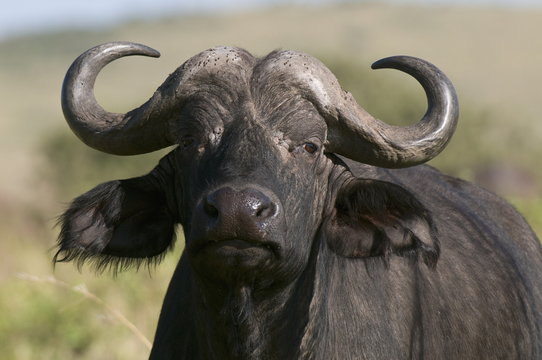Have you ever wondered why water buffalo horns keep growing throughout their lives? Unlike antlers, which shed and regrow annually, buffalo horns continuously grow—a unique adaptation that serves multiple biological and ecological purposes.
In this article, we’ll explore the science behind horn growth, the biological composition of buffalo horns, and the evolutionary advantages of this trait. If you're interested in zoology, animal adaptations, or evolutionary biology, this deep dive will answer your questions.

Water buffalo horns are primarily composed of keratin, the same protein that makes up human hair and nails, as well as hooves and feathers in other animals. However, unlike deer antlers, which are made of bone, buffalo horns have a bony core covered with a thick keratin sheath.
This structure is what allows buffalo horns to grow continuously without shedding. The bony core remains fixed to the skull, while the keratin layer grows outward, adding to the horn’s length and girth over time.
Keratin regenerates continuously, unlike bone, which needs to be broken down and rebuilt.
Horns are not shed like antlers, meaning growth is a lifelong process.
Nutritional intake affects growth, especially protein, minerals, and vitamins.
This unique structure provides both strength and flexibility, making horns effective for defense, dominance, and survival.
Buffalo horns grow because of keratinocyte cells at the base of the horn, which continuously produce new keratin layers. These layers harden over time, increasing horn thickness and length.
While keratin covers the exterior, the bony core also expands slowly, providing a stable internal structure for the horn. Unlike deer, which regrow antlers annually, buffaloes retain their horns for life, with growth occurring year-round.
Diet: High-protein diets rich in amino acids, calcium, and phosphorus accelerate keratin production.
Genetics: Different breeds have varying horn growth patterns. Some domesticated buffaloes have larger horns due to selective breeding.
Age: Young buffaloes experience the fastest horn growth, which slows as they age.
Health Conditions: Malnutrition or disease can cause stunted horn growth or deformities.
Water buffalo evolved large, continuously growing horns due to natural selection. These horns serve multiple survival functions:
Buffalo horns act as a natural defense mechanism against predators like tigers, crocodiles, and wild dogs. Larger, well-developed horns increase survival chances in the wild.
In the animal kingdom, larger horns often indicate strength, helping males compete for mates. Bulls with bigger horns are often more dominant in herds, gaining access to better resources and breeding opportunities.
Recent studies suggest that large horns help with heat dissipation, especially in hot, humid environments where water buffalo thrive. The horns contain vascular structures that aid in body temperature regulation.
| Feature | Buffalo Horns | Deer Antlers |
|---|---|---|
| Composition | Keratin + Bone | Bone (Shed Annually) |
| Growth | Continuous | Regrows Annually |
| Shedding | Never | Falls Off Annually |
| Function | Defense, Mating, Thermoregulation | Mating & Combat |
Water buffalo horns grow larger and heavier than those of most goats and sheep due to differences in genetic programming and environmental adaptations.
Buffalo horns have been used for centuries in:
Traditional crafts (carved decorations, jewelry, and utensils)
Musical instruments (horns and wind instruments)
Traditional medicine (though effectiveness is scientifically debated)
With growing concerns about wildlife conservation, ethical buffalo farming promotes sustainable use of horns without harming animals. Unlike ivory harvesting, buffalo horn collection does not require killing the animal, making it a more sustainable alternative.
Wild water buffalo (Bubalus arnee) are endangered, with habitat loss and hybridization threatening their survival. Conservation efforts focus on:
Protecting natural habitats
Preventing illegal poaching for horn trade
Sustainable buffalo farming to reduce pressure on wild populations
Water buffalo horns grow continuously due to keratin production, bone support, and evolutionary adaptations. This biological trait plays a crucial role in protection, dominance, and environmental adaptation.
Understanding horn growth not only enhances our knowledge of bovine biology but also supports wildlife conservation and ethical farming practices.
✅ Buffalo horns grow continuously due to keratin production
✅ They serve defensive, social, and thermoregulatory roles
✅ Growth is influenced by genetics, diet, and environment
✅ Conservation efforts are crucial for wild buffalo survival
By studying water buffalo horns, we gain deeper insight into evolution, biodiversity, and sustainable resource use.
Banks, W. (2020). Bovidae Evolution and Adaptations. Oxford University Press.
Choudhury, A. (2018). Wild Water Buffalo: Conservation Challenges and Strategies. Journal of Wildlife Ecology.
Smith, J. (2019). Keratin Biology and Its Role in Animal Horn Growth. Nature Biotech Research.
FAO (2022). Water Buffalo Farming and Sustainability. Food and Agriculture Organization Report.
animal tags: Bovidae
We created this article in conjunction with AI technology, then made sure it was fact-checked and edited by a Animals Top editor.